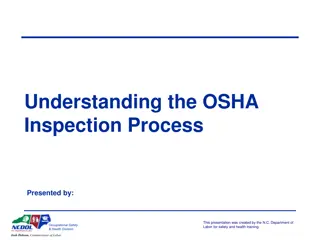Improving Real Estate Assessment Center (REAC) Inspections: National Standards for the Physical Inspection of Real Estate (NSPIRE) Overview
The National Standards for the Physical Inspection of Real Estate (NSPIRE) aims to address the shortcomings in current inspection models for HUD and HUD-assisted properties. The Inspection Task Force is reexamining REAC inspections to focus on health and safety hazards, year-round maintenance practices, and property quality. The 2-track approach involves immediate changes and complete overhaul of the inspection process. The 14-calendar day inspection notification enhances year-round maintenance, cost reduction, and property reinvestment.
Download Presentation

Please find below an Image/Link to download the presentation.
The content on the website is provided AS IS for your information and personal use only. It may not be sold, licensed, or shared on other websites without obtaining consent from the author. Download presentation by click this link. If you encounter any issues during the download, it is possible that the publisher has removed the file from their server.
E N D
Presentation Transcript
Improving Real Estate Assessment Center (REAC) Inspections: National Standards for the Physical Inspection of Real Estate (NSPIRE) Leading Age - May 13, 2019
Overview Overview The Problem Inspection Task Force Current protocol efforts The NSPIRE model NSPIRE demonstration 2
The Problem The Problem While a significant majority of HUD and HUD-assisted properties are safe and in a quality condition, a new inspection model is needed to expediently address properties that are not. Issues include: Inspections do not always identify the extent of health and safety conditions affecting residents Properties can pass inspection even with poor unit conditions Scoring model no longer aligns with expectations about housing quality Some owners preparing for inspections, rather than performing maintenance year-round Deficiencies are not all Critical to Quality (CTQ) 3
Inspection Task Force Mission Inspection Task Force Mission Conduct a wholesale reexamination of REAC inspections Place the greatest emphasis on eliminating health and safety hazards Ensure owners adopt sound maintenance practices year-round 4
2 Track Approach 2 Track Approach Track 1 Immediate Changes to the Current System 14 Day Notice Eliminating the Reverse Auction Program Carbon Monoxide Survey Track 2 Complete Review and Overhaul of the Inspection Process 5
14 Calendar Day Inspection Notification 14 Calendar Day Inspection Notification Achieves a more accurate picture of how the property is being maintained year-round Reduces significant costs spent for inspection preparation and promotes reinvestment into the property year-round General Concept Property notified 14 calendar days before the inspection Unless state or local law requires a longer resident notification window If property cancels, the score will be a zero One additional reinspection within 7 calendar days; otherwise, score held at zero Notice Released Feb 22, 2019; Effective March 25, 2019 https://www.hud.gov/sites/dfiles/PIH/documents/PIH-2019-02.pdf First auction contracts under new policy just recently awarded 6
Carbon Monoxide (CO) Detector Survey Carbon Monoxide (CO) Detector Survey HUD/REAC Inspector Notice 2019-01 requires survey for CO detectors in buildings/units with fuel-fired appliances or connected garages. Units in States Not Requiring CO Detector Units in States Requiring CO Detector Total Missing 483 2034 2517 Working 205 4191 4396 Not Working 28 243 271 Number of Inspections: 1019 Number with CO source: 366 * As of April 24, 2019 7
Goals of NSPIRE Demonstration Goals of NSPIRE Demonstration Ensure families are living in decent and safe housing Enhance accuracy through: Better identification of substandard properties Increased objectivity and defensibility of inspections Streamlined inspection processes 8
NSPIRE Timeline NSPIRE Timeline NSPIRE: New Standards, Protocols, and Processes Demonstration Notice Released Demonstration Listening Sessions Initiate POA Self- Inspections Initiate Contractor Inspections Initiate Government Inspections Initiate New Scoring Model Stakeholder Outreach FY2019 FY2021 Analysis & Design Demonstration Execution: Test, Evaluate, Validate & Refine Reverse Auction Program Replacement FY2020 14 Day Notice Released 14 Day Notice Effective Changes To Current Process 9
NSPIRE Demonstration Phasing Plan NSPIRE Demonstration Phasing Plan Significant Milestones Demonstration Official Start Draft NSPIRE Stnds Interim Rule Effective; Final Standards & Scoring Published 1st NSPIRE Inspections Conducted to Test Standards Listening Sessions Completed 1st Self- Inspection Collected Advisory Scores and TA Continue Validated NSPIRE Standards First Scores Generated Interim Rule Published 4/1/2019 7/1/2019 10/1/2019 1/1/2020 4/1/2020 7/1/2020 10/1/2020 10/1/2021 R R 4 R 6 R 5 Onboard Region 3 R R 1&2 7&8 9&10 Q3FY20 Q4FY20 Q3FY19 Q4FY19 Q2FY20 Q1-Q4FY21 Q1FY20 10
NSPIRE Model NSPIRE Model - - Conceptual View Conceptual View 3 Types of Inspections Confidence Increased Property Owner/Agent (POA) Self-Inspections REAC Contracted Inspections HUD Quality Assurance Inspections 3 Categories of Deficiencies Resident Focused Safety and Health Function and Operability Condition and Appearance 3 Inspectable Areas Complexity Reduced Unit Inside Outside NSPIRE Model 3 Types of Inspections 3 Inspectable Areas 3 Categories of Deficiencies Underpinned by 3 mutually supporting components 11
NSPIRE: 3 Types of Inspections NSPIRE: 3 Types of Inspections POA Self-Inspections Who: Property Owners/Management What: All deficiencies reported to HUD When: Once a year Where: All units Why: To gain a reasonable level of confidence in results & To ensure work orders are being generated Reasonable assurance into property s condition REAC Contracted Inspections Who: Contract Inspectors What: CTQs When: Periodic inspections (3, 2, 1 years) Where: High sample rate Why: To gain a high level of confidence in results HUD Federal Employee Inspections Who: HUD Federal Inspectors What: CTQs++ When: Triggered by poor conditions Where: Highest sample rate Why: To gain the highest level of confidence in results Evidentiary support to enforcement and/or sanctions *CTQs = Critical to Quality Indicators; Inspection standards that have a high correlation to quality 12
NSPIRE: 3 Categories of Deficiencies NSPIRE: 3 Categories of Deficiencies Precision CTQs Per Category ResponseLevel Safety & Health Urgent: Emergency Work Order Objective Function & Operability Planned: Routine Work Order Condition & Appearance Subjective Programmed: Discretionary Maintenance 13
NSPIRE: 3 Inspectable Areas NSPIRE: 3 Inspectable Areas CURRENT NEW 5 INSPECTABLE AREAS 3 INSPECTABLE AREAS 5 Inspectable areas will feed into the 3 new inspectable areas Simplified, intuitive approach based on the inspectable item s physical location Dwelling Units Dwelling Units Failure Threshold Value 35% 50% Building Systems Property won t pass overall inspection if the Dwelling Units inspectable area fails. 20% Common Areas 25% 15% Inside Building Exterior 15% Outside 25% 15% Site 14
Demonstration Roadmap Demonstration Roadmap Multi-year, multi-phase effort consisting of: Demonstration preparation Currently ongoing Finalize strategy (vision, goals, objectives) Develop items to be evaluated (elements of NSPIRE to include new deficiencies) Develop test criteria and metrics Compare results with criteria and adjust accordingly Solicitation and selection of properties (Preference to Region III) Phase I POA self-inspections - Begins in 3rd Quarter FY2019 Leverages existing requirement to conduct annual unit inspections Participants will inspect and submit results to HUD Self-inspections evaluated but not scored Phase II CTQ inspections - Begins in 4th Quarter FY2019 Comprised of contractor and government employees using new standards Assesses new standards and protocols Development of new scoring model 16
Demonstration Inspection Scoring Demonstration Inspection Scoring Properties will be inspected during the 2-year Demonstration Demonstration inspections will be in lieu of UPCS inspections Scores are only advisory If conditions warrant, HUD will reinspect using UPCS 17
Summary Summary Changes needed to protect families and ensure the inspection results reflect the property s true physical condition Changes will be tested during a 2-year demonstration Feedback will be collected from stakeholders through listening sessions and other methods of outreach Demonstration expected beginning Q3 FY19 18
Your feedback Your feedback Questions & Comments NSPIRE@hud.gov or Search on HUD NSPIRE 19























